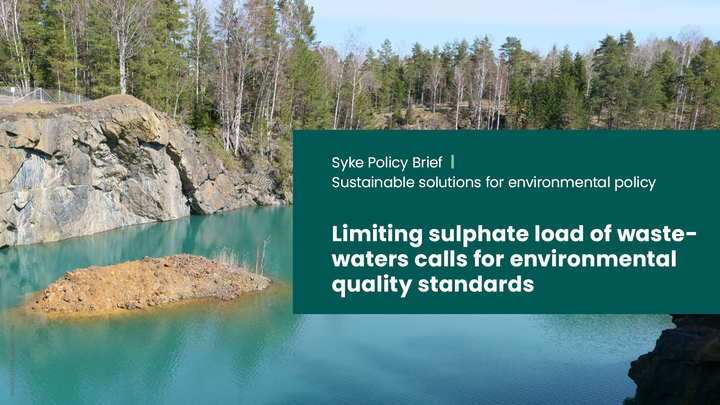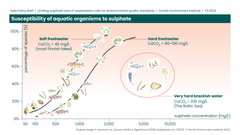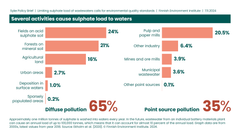Policy Brief: Limiting sulphate load of wastewaters calls for environmental quality standards
The clean energy transition and the green transition are bringing mining and battery technology industries to Finland. As a result, sulphate discharges into inland waters and the Baltic Sea will increase. Sulphate also has beneficial effects in water bodies, and it is not currently classified as a harmful substance. However, a high local load may adversely affect aquatic organisms, especially in lakes with a naturally low sulphate concentration. In its new Policy Brief, the Finnish Environment Institute issues recommendations for reducing the harmful effects of the sulphate load in wastewaters.

New ways of producing and storing energy are necessary in order to mitigate climate change. To achieve this, mining and battery technology industries are also needed in Finland. Particular concerns have been raised recently over large sulphate discharges of wastewaters into water bodies. “New studies have shown that sulphate can harm organisms, especially in lakes,” says Jouni Lehtoranta, Senior Researcher at the Finnish Environment Institute. This issue is also topical because a revision of the Government Decree on Substances Dangerous and Harmful to the Aquatic Environment is about to be launched.
Sulphate is harmful to lake organisms
The concentration of sulphate that is harmless to organisms has been studied by the University of Jyväskylä and the Finnish Environment Institute. “Toxicity tests indicate that a high load may have adverse effects on aquatic organisms, especially in lakes with naturally low sulphate concentration. In the Baltic sea, organisms adapted to salinity appear to tolerate much higher sulphate concentrations than those in lakes,” says Matti Leppänen, Senior Researcher at the Finnish Environment Institute.
Both short-term and long-term sulphate exposure tests were carried out on organisms in inland waterways and the brackish water of the Baltic Sea. The safe sulphate concentration in long-term exposure in freshwaters varied between 39 and 65 milligrams per litre. In short-term exposure, the concentration varied between 257 and 339 milligrams per litre. “We are still working on safe concentrations for brackish water species, but the harmless concentration seems to be significantly higher than in lakes,” says Leppänen.
Finnish Environment Institute proposes limit values
Sulphate is not currently classified as a harmful substance, and it is not included in the Finnish Decree on Substances Dangerous and Harmful to the Aquatic Environment. "Sulphate should be added to the Decree, and scientifically derived environmental quality standards should be set for it," says Jukka Mehtonen, Senior Coordinator at the Finnish Environment Institute.
Separate standards are needed for inland and coastal waters. The Finnish Environment Institute’s proposal for the quality standard of annual average concentration is 39 milligrams per litre for inland waters and 279 milligrams per litre for instantaneous concentration. As the studies are completed, environmental quality standards for sulphate will also be proposed for coastal waters.
“The harmful effects of sulphate can be mitigated by placing the wastewater discharge site in an area where the wastewater will dilute rapidly, and the dilute wastewater flows downstream or into the open sea. The most suitable discharge site can be found by modelling. Options for removing sulphate during manufacturing processes should also be investigated,” says Jouni Lehtoranta.
Mining and battery technology industries are essential in the green transition. However, the publication stresses that in green transition projects, it is also important to examine the overall environmental impacts, including on air, soil and water, as well as the life cycle impacts of manufacturing.
Further information
Jouni Lehtoranta, Senior Researcher, Finnish Environment Institute Syke, tel. +358 295 251 363, firstname.lastname@syke.fi
Matti Leppänen, Senior Researcher (studies on harmful effects of sulphates), Finnish Environment Institute Syke, tel. +368 295 251 368, firstname.lastname@syke.fi
Jukka Mehtonen, Senior Coordinator (Decree on Substances Dangerous and Harmful to the Aquatic Environment), Finnish Environment Institute Syke, tel. +358 295 251 421, firstname.lastname@syke.fi
Antti Belinskij, Research Professor (Environmental Law), Finnish Environment Institute Syke, +358 295 251 088, firstname.lastname@syke.fi
All Syke Policy Briefs:
Keywords
Contacts
Media service at Finnish Environment Institute
Our Media Service provides information on research, helps journalists find experts for interviews and provides photos for media use.
Our Communication experts will answer your inquiries on weekdays from 9 am to 4 pm.
Images
Finnish Environment Institute - We build hope through research.
Finnish Environment Institute
Latokartanonkaari 11
00790 Helsinki
+358 295 251 000
It is time to move beyond solving environmental problems one by one, to systemic sustainability transformations. The Finnish Environment Institute (Syke) contributes to building a sustainable society through research, information and services. The Finnish Environment Institute is a research institute with 700 experts and researchers located in Helsinki, Oulu, Jyväskylä and Joensuu.

Subscribe to releases from Suomen ympäristökeskus
Subscribe to all the latest releases from Suomen ympäristökeskus by registering your e-mail address below. You can unsubscribe at any time.
Latest releases from Suomen ympäristökeskus
Nuoret vaativat merkittäviä muutoksia ruuan kulutukseen ja tuotantoon16.12.2025 12:00:00 EET | Tiedote
Nuorten ruokaraati vaatii avointa ja tutkittua tietoa ruuasta – sen alkuperästä, tuotantotavoista ja vaikutuksista ilmastoon, luontoon ja hyvinvointiin. Ilman selkeitä faktoja vastuulliset kulutusvalinnat eivät ole mahdollisia. Nuoret luovuttavat kannanottonsa kansalliseen ruokastrategiaan 2040 maa- ja metsätalousministeriön tilaisuudessa 16.12.2025.
Kommunernas utsläpp fortsätter minska – trafikens andel av utsläppen ökar16.12.2025 06:00:00 EET | Pressmeddelande
Enligt förhandsberäkningsuppgifterna för 2024 minskade Finlands växthusgasutsläpp enligt Hinku-beräkningsreglerna med cirka fem procent jämfört med föregående år. På lång sikt har utsläppen sedan år 2005 minskat med 40 procent och jämfört med år 1990 med 43 procent.
Kuntien päästöt laskevat edelleen – liikenteen osuus päästöistä kasvaa16.12.2025 06:00:00 EET | Tiedote
Vuoden 2024 ennakkolaskentatietojen perusteella Hinku-laskentasääntöjen mukaiset Suomen kasvihuonekaasupäästöt laskivat noin viisi prosenttia edelliseen vuoteen verrattuna. Pitkällä aikavälillä vuodesta 2005 lähtien päästöt ovat vähentyneet 40 prosenttia ja vuoteen 1990 verrattuna 43 prosenttia.
Viikkokatsaus 15.–19.12.202511.12.2025 12:59:58 EET | Tiedote
Hei! Tässä tiedoksesi meillä Suomen ympäristökeskuksessa ensi viikolla ilmestyviä tiedotteita, uutisia, kampanjoita, blogeja ja uutiskirjeitä. Mukana myös tulevia tapahtumia ja webinaareja. Jakelemme viikkokatsauksen torstaisin STT:n kautta. Koosteet löytyvät myös STT-uutishuoneesta, josta voit tilata kaikki Suomen ympäristökeskuksen tiedotteet.
Viikkokatsaus 8.–12.12.20254.12.2025 12:30:18 EET | Tiedote
Hei! Tässä tiedoksesi meillä Suomen ympäristökeskuksessa ensi viikolla ilmestyviä tiedotteita, uutisia, kampanjoita, blogeja ja uutiskirjeitä. Mukana myös tulevia tapahtumia ja webinaareja. Jakelemme viikkokatsauksen torstaisin STT:n kautta. Koosteet löytyvät myös STT-uutishuoneesta, josta voit tilata kaikki Suomen ympäristökeskuksen tiedotteet.
In our pressroom you can read all our latest releases, find our press contacts, images, documents and other relevant information about us.
Visit our pressroom

